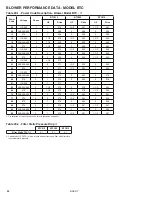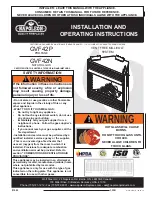
28
6-563.7
servICe / mAInTenAnCe / TrouBlesHooTIng
general maintenance
The unit and venting system must be checked once a year by a
qualified service technician.
All installation and service of these units must be
performed by a qualified installation and service agency.
Before any service, Be sure To Turn off gAs AT THe
mAnuAl sHuT-off vAlve AHeAd of THe ComBInATIon
gAs ConTrol And Turn off All eleCTrIC PoWer To
THe HeATer.
CAUTION
1. Service or repair of this equipment must be performed by
a qualified service agency.
2. Do not attempt to reuse any mechanical or electrical
controllers which have been wet. Replace defective
controller.
WARNING
When servicing or repairing this equipment, use only
factory-approved service replacement parts. A complete
replacement parts list may be obtained by contacting the
factory. Refer to the rating plate on the appliance for
complete appliance model number, serial number, and
company address. Any substitution of parts or controls not
approved by the factory will be at the owner’s risk.
1. Service air moving components annually.
a. Check fan for fit on motor shaft and for damage to blades.
2. Keep unit free from dust, dirt, grease, and foreign matter,
paying particular attention to:
a. Combustion air inlets.
b. Burners and burner orifices. Open the union on the gas
line, and disconnect the igniter and sensor wires. Remove
the screws that attach the burner tray to the header plate
and remove the burner tray and manifold assembly from
the heater. Carefully clean the burners with a wire brush
or other suitable means.
Replace any damaged or deteriorating burners or orifices.
Verify that the burners are touching each other at the
carryover points. This will ensure flame carryover from
burner to burner. Install the burner assembly back on to
the header making certain that all screws, pipes and
electrical connections are tight.
c. Clean exterior of heat exchanger tubes. For cleaning the
fins on the secondary heat exchanger, either use a soft
brush and vacuum cleaner or use a compressed air hose
though the discharge opening of the unit (the opening with
the louvers) to blow the debris out of the fins.
d. Fan blades.
3. Inspect the flame sensor and igniter for deterioration and/or
cracks.
CAuTIon: Be careful when handling the igniter and flame
sensor.
4. Check wiring for possible loose connections.
5. The gas valves and piping should be checked annually for
general cleanliness and tightness. The gas controls should
be checked to insure that the unit is operating properly. See
control instruction sheets furnished separately with the unit
heater.
6. The power exhaust motor bearings have been lubricated for
long life and do not require additional lubrication. In dirty
atmospheres, it may be desirable to clean the motors and
blower housing and blow out the cooling air passages of the
motor with compressed air.
7. Perform periodic cleaning of inlet and vent terminal screens.
8. Clean the condensate drain traps and refill with water.
9. If a condensate pump is being used with overhead
condensate drain lines, inspect the pump for proper
operation and maintain per the pump manufacturer’s
instructions. Replace the condensate pump treatment tablets
if equipped.
10. If a condensate neutralizer tube is installed, recharge per the
neutralizer tube manufacturer’s instructions.
11. Check the condensate overflow switch for cleanliness and
proper operation.
noTe: To check most of the Possible Remedies in the
troubleshooting guide listed in Table 29.1, refer to the applicable
sections of the manual.





































